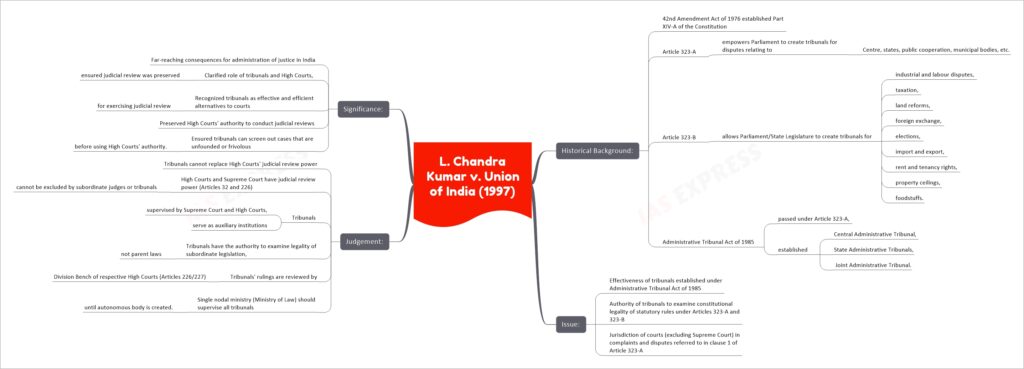L. Chandra Kumar v. Union of India (1997) – On the Authority of Administrative Tribunals in India
The L Chandra Kumar Case is a landmark case that dealt with the questions of the constitutional validity of tribunals and the extent of their jurisdiction. In this article, we will explore the historical background of the case, the issues that were raised in court, the judgment and its significance.
Background of the Case:
- The 42nd Amendment Act of 1976 established Part XIV-A of the Constitution, titled “Tribunals”.
- Article 323-A empowers Parliament to create tribunals for disputes relating to the Centre, states, public cooperation, municipal bodies, and other public authorities.
- Article 323-B allows both Parliament and the State Legislature to create tribunals for industrial and labour disputes, taxation, land reforms, foreign exchange, elections, import and export, rent and tenancy rights, property ceilings, and foodstuffs.
- The Administrative Tribunal Act of 1985 was passed in accordance with Article 323-A and established Central Administrative Tribunal, State Administrative Tribunals, and Joint Administrative Tribunal.
Issue in the Case:
- Effectiveness of tribunals established under the Administrative Tribunal Act of 1985 as substitutes for High Courts in exercising the power of judicial review.
- Authority of tribunals to examine the constitutional legality of statutory rules under Articles 323-A and 323-B of the Indian Constitution.
- Jurisdiction of courts (excluding Supreme Court under Article 136) in complaints and disputes referred to in clause 1 of Article 323-A.
Judgement of the Case:
- Tribunals cannot replace High Courts’ judicial review power.
- High Courts and Supreme Court have judicial review power (Articles 32 and 226) and cannot be excluded from judicial review of legislative actions by subordinate judges or tribunals.
- Tribunals are supervised by the Supreme Court and High Courts and serve as auxiliary institutions.
- Tribunals have the authority to examine the legality of subordinate legislation, but not parent laws.
- Tribunals’ Rulings are reviewed by the Division Bench of respective High Courts (Articles 226/227).
- A single nodal ministry (Ministry of Law) should be established to supervise all tribunals until a truly autonomous body is created.
Significance
- The L Chandra Kumar Case had far-reaching consequences for the administration of justice in India.
- The case clarified the role of tribunals and the High Courts and ensured that the fundamental element of the Constitution, judicial review, was preserved.
- The tribunals were recognized as effective and efficient alternatives to the courts for the purposes of exercising judicial review.
- The case ensured that the High Courts’ authority to conduct judicial reviews was preserved and that tribunals could screen out cases that were unfounded or frivolous before the High Courts’ authority was used.
This article is part of the series “Landmark Judgements that Shaped India” under the Indian Polity Notes & Prelims Sureshots. We aim to make the articles comprehensive while leaving out unnecessary information from the UPSC perspective. If you think this article is useful, please provide your feedback in the comments section below.


